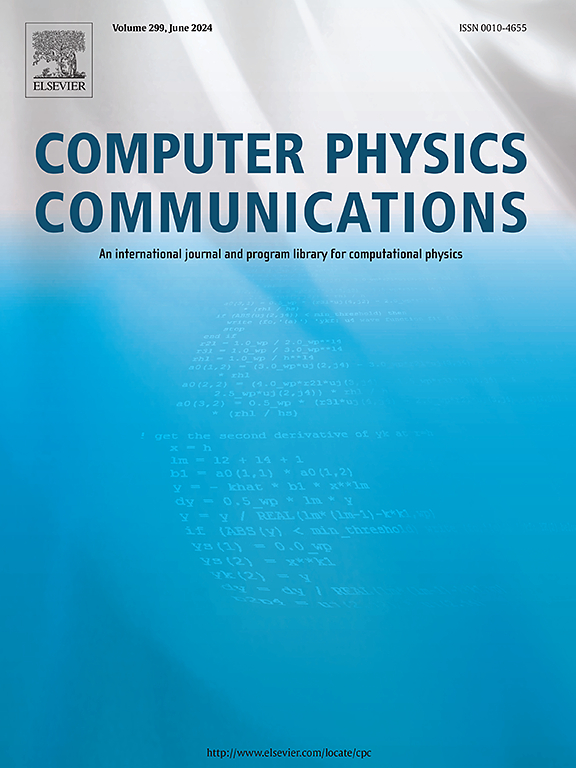Hybrid multi-head physics-informed neural network for depth estimation in terahertz imaging
IF 7.2
2区 物理与天体物理
Q1 COMPUTER SCIENCE, INTERDISCIPLINARY APPLICATIONS
引用次数: 0
Abstract
Terahertz (THz) imaging is a topic in the field of optics, that is intensively investigated not least due to its potential for recording three-dimensional (3D) images, useful e.g., for the detection of hidden objects, nondestructive testing, and radar-like imaging in conjunction with automotive systems. Depth information retrieval is a key factor to recover the three-dimensional shape of objects. Impressive results for depth determination in the visible and infrared spectral range have been demonstrated through deep learning (DL). Among them, most DL methods are merely data-driven, lacking relevant physical priors, which thus requires a large amount of experimental data to train the DL models. However, acquiring large training data in the THz domain is challenging due to the time-consuming data acquisition process and environmental and system stability requirements during this lengthy process. To overcome this limitation, this paper incorporates a complete physical model representing the THz image formation process into a DL neural network(NN). Having addressed phase retrieval and image reconstruction of planar objects in an earlier paper, we focus here on the task to retrieve the distance information of objects. A significant goal of our work is to be able to use the DL NNs without pre-training, eliminating the need for tens of thousands of labeled data. Through experimental validation, we demonstrate that by providing diffraction patterns of planar objects, with their upper and lower halves sequentially masked to overcome the trapping of the NN's computational iterations in local minima, the proposed physics-informed NN can automatically reconstruct the depth of the object through interaction between the NN and the physical model. Compared to traditional DL methods and back-propagation methods, our approach not only reduces data dependency and operational costs but also improves imaging speed and stability. The obtained results also represent the initial steps towards achieving fast holographic THz imaging using reference-free beams and low-cost power detection.
用于太赫兹成像深度估计的混合多头物理信息神经网络
太赫兹(THz)成像是光学领域的一个主题,主要是因为它具有记录三维(3D)图像的潜力,例如用于检测隐藏物体、无损检测和与汽车系统相结合的雷达成像。深度信息检索是恢复物体三维形状的关键因素。通过深度学习(DL)展示了在可见和红外光谱范围内深度确定的令人印象深刻的结果。其中,大多数深度学习方法仅仅是数据驱动的,缺乏相关的物理先验,这就需要大量的实验数据来训练深度学习模型。然而,由于数据采集过程耗时,并且在这个漫长的过程中对环境和系统稳定性的要求,在太赫兹域获取大型训练数据是具有挑战性的。为了克服这一限制,本文将代表太赫兹图像形成过程的完整物理模型纳入深度学习神经网络(NN)。在之前的文章中,我们已经讨论了平面物体的相位检索和图像重建,这里我们重点研究了物体距离信息的检索任务。我们工作的一个重要目标是能够在没有预训练的情况下使用深度学习神经网络,从而消除对数万个标记数据的需求。通过实验验证,我们证明了通过提供平面物体的衍射图案,将其上下半部分依次屏蔽以克服神经网络计算迭代在局部极小值中的捕获,所提出的物理通知神经网络可以通过神经网络与物理模型之间的相互作用自动重建物体的深度。与传统的深度学习方法和反向传播方法相比,我们的方法不仅降低了数据依赖性和操作成本,而且提高了成像速度和稳定性。获得的结果也代表了使用无参考光束和低成本功率检测实现快速全息太赫兹成像的初步步骤。
本文章由计算机程序翻译,如有差异,请以英文原文为准。
求助全文
约1分钟内获得全文
求助全文
来源期刊

Computer Physics Communications
物理-计算机:跨学科应用
CiteScore
12.10
自引率
3.20%
发文量
287
审稿时长
5.3 months
期刊介绍:
The focus of CPC is on contemporary computational methods and techniques and their implementation, the effectiveness of which will normally be evidenced by the author(s) within the context of a substantive problem in physics. Within this setting CPC publishes two types of paper.
Computer Programs in Physics (CPiP)
These papers describe significant computer programs to be archived in the CPC Program Library which is held in the Mendeley Data repository. The submitted software must be covered by an approved open source licence. Papers and associated computer programs that address a problem of contemporary interest in physics that cannot be solved by current software are particularly encouraged.
Computational Physics Papers (CP)
These are research papers in, but are not limited to, the following themes across computational physics and related disciplines.
mathematical and numerical methods and algorithms;
computational models including those associated with the design, control and analysis of experiments; and
algebraic computation.
Each will normally include software implementation and performance details. The software implementation should, ideally, be available via GitHub, Zenodo or an institutional repository.In addition, research papers on the impact of advanced computer architecture and special purpose computers on computing in the physical sciences and software topics related to, and of importance in, the physical sciences may be considered.
 求助内容:
求助内容: 应助结果提醒方式:
应助结果提醒方式:


